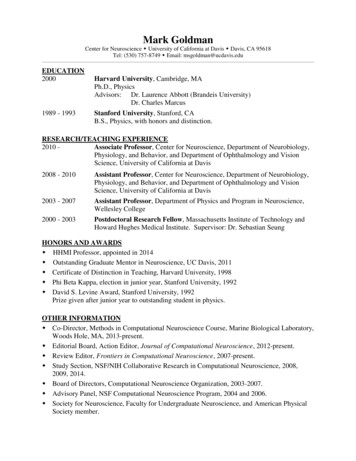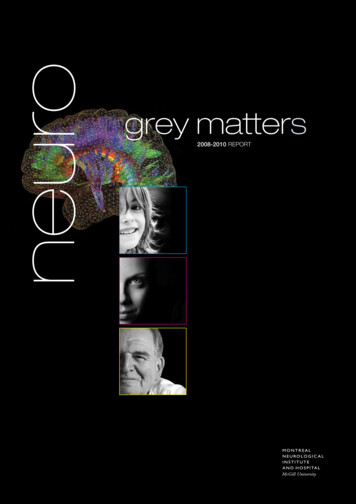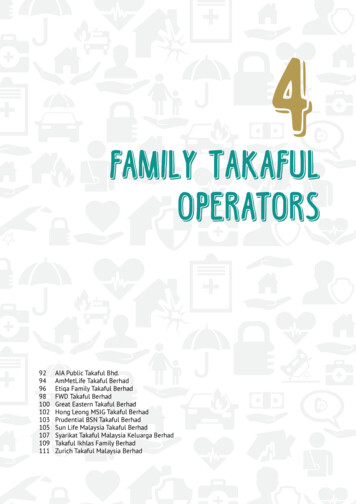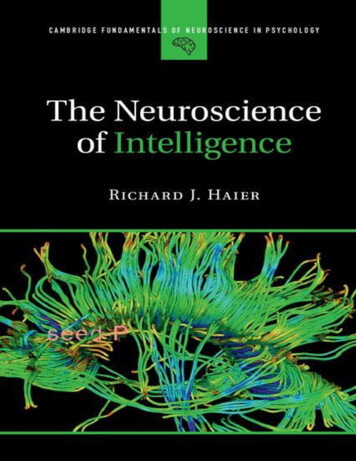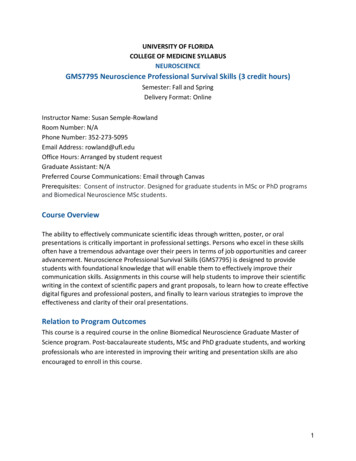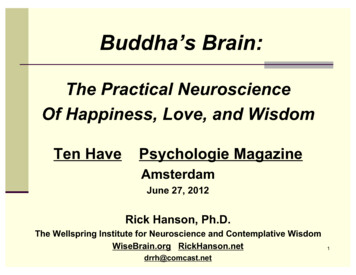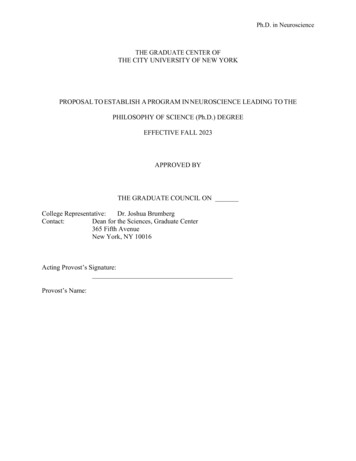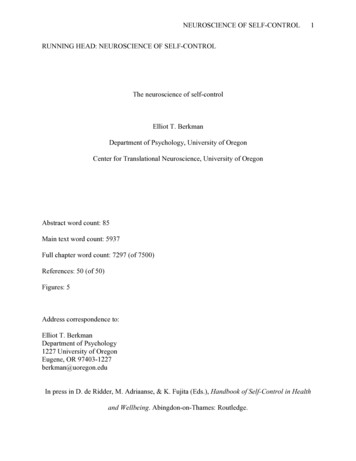
Transcription
NEUROSCIENCE OF SELF-CONTROL1RUNNING HEAD: NEUROSCIENCE OF SELF-CONTROLThe neuroscience of self-controlElliot T. BerkmanDepartment of Psychology, University of OregonCenter for Translational Neuroscience, University of OregonAbstract word count: 85Main text word count: 5937Full chapter word count: 7297 (of 7500)References: 50 (of 50)Figures: 5Address correspondence to:Elliot T. BerkmanDepartment of Psychology1227 University of OregonEugene, OR 97403-1227berkman@uoregon.eduIn press in D. de Ridder, M. Adriaanse, & K. Fujita (Eds.), Handbook of Self-Control in Healthand Wellbeing. Abingdon-on-Thames: Routledge.
NEUROSCIENCE OF SELF-CONTROLAbstractThis chapter describes why and how neuroscience methods can be useful for self-control theoryand research. The author contrasts two models of self-control, the opposition and valuationmodel, with an emphasis on how each characterizes the mechanisms self-control. Next, theauthor reviews recent neuroscience relevant to each model derived from functional magneticresonance imaging studies. The author closes by offering an integrated account of how selfcontrol operates at a neurocognitive level, and suggesting ways that self-control might beimproved in light of the neurally-informed model.2
NEUROSCIENCE OF SELF-CONTROL3It seems that no literature within psychology is complete these days without some data on theneural correlates of the topic. This is true of self-control, which is certainly above the mean andmight even be an outlier in terms of the exceptionally large quantity of relevant neuroscientificdata. The purpose of this chapter is to provide a useful framework for thinking about those datarather than to provide a comprehensive review of them. Another goal is to critically evaluate thepossible contributions of neuroscience to the study of self-control.I begin by articulating several reasons why knowledge of brain function can improvepsychological models of self-regulation. I then describe classes of two models of self-control thathave guided neuroscientific study. Next, I explain how the neuroscientific data from the modelsare largely convergent and outline a few points of difference that need to be reconciled. I closeby describing future directions for self-control research where neuroimaging could beparticularly impactful.Why should self-control researchers study the brain?I do not take it for granted that obtaining a map that links brain regions to mental processes willnecessarily be useful for understanding self-control. There are many reasons I do not make thisassumption, but two are especially pertinent here. First, the map between a given brain regionand a given mental process is many-to-many. The neural regions recruited during self-control areinvolved in many other processes, so merely observing that one or more of those regions wasactive during a task does not necessarily imply that self-control occurred. This so-called “reverseinference” problem limits the ability of researchers to infer mental process from brain data alone(Poldrack, 2006). Second, the number of tools that exist to alter brain function directly and with
NEUROSCIENCE OF SELF-CONTROL4some degree of specificity is very small. So, even if research were to identify a brain region ornetwork that is causally involved in effective self-control (e.g., self-control cannot be performedif that region or network is lesioned, and self-control only requires that region or network),interventions would be unlikely to be able to target it. I refer to this as the “so what?” problembecause it limits the significance of obtaining even high-quality inferential knowledge of how thebrain executes self-control.However, there are also reasons to be hopeful. The root of the reverse inference problem is thatthe mapping between mental processes and neural activations is complex, but not ultimatelyunknowable. Accurate reverse inference is possible given sufficient information about the baserates of activation and the likelihood of a task invoking a particular process (Poldrack, Kittur,Kalar, Miller, Seppa, Gil, et al., 2011). If activation in Region X is rare across all cognitiveneuroscience studies but common in studies that elicit Process A, then there is a reasonablechance that Process A is involved in a new task if activation is observed in Region X. Indeed, acentral purpose of NeuroSynth, a software platform of large-scale automated meta-analysis ofneuroimaging data, is to uncover region-specific base rates of activation to enable valid reverseinference (Yarkoni, Poldrack, Nichols, Van Essen, & Wager, 2011). This tool, as well as thebroader movement toward Bayesian approaches that leverage prior information about aphenomenon to refine scientific knowledge, are only just beginning. The ability of scientists toinfer mental processes from brain activation will grow rapidly as more knowledge accumulatesand the tools available to take advantage of that knowledge are developed.The “so what” problem relating to the difficulty of directly altering brain function is also offset
NEUROSCIENCE OF SELF-CONTROL5for two reasons. First, in extreme cases, it is possible to alter the brain through direct surgical orpharmacological manipulation. Deep brain stimulation of the subgenual anterior cingulate cortex,for example, can be effective against treatment-resistant forms of depression (Mayberg, Lozano,Voon, McNeely, Seminowicz, Hamani, et al., 2005), and certain classes of drugs can effectivelytreat substance use by acting on receptors that otherwise would bind to the abused substance (LeFoll, Ciano, Panlilio, Goldberg, & Ciccocioppo, 2013). Emerging neurostimulation methods suchas transcranial direct current stimulation (tDCS) also enable researchers to manipulate brainactivity in a less invasive way, and these methods have been shown to be effective in alteringbrain function in specific neural areas implicated in disorder (Nitsche, Boggio, Fregni, &Pascual-Leone, 2009).Second, it is also possible to alter brain function through indirect routes. A novel and innovativeclass of psychosocial “brain-training” interventions are beginning to emerge that can target keysystems, such as the regions of the frontrostriatal motor planning and implementation networkthat are involved in inhibitory control (Berkman, Kahn, & Merchant, 2014; see Bryck & Fisher,2012, for a summary). These interventions use behavioral or psychosocial means, such asnarrowly focused neurocognitive tasks, to engage and thereby alter the function of specificneural systems. Brain-training protocols are grounded in basic cognitive, affective, and socialneuroscience research that identifies procedures to elicit activity in the targeted networks.Discovery of new protocols is somewhat haphazard at this preliminary stage in the field’sdevelopment because a coherent framework for intervention development is lacking: Given aspecific neural system, what is the procedure for creating an intervention that might alter it? Alogical starting point is training based on associative learning or classical conditioning. Examples
NEUROSCIENCE OF SELF-CONTROL6of recent successes based on these approaches include cognitive training to target proactivecontrol in the lateral prefrontal cortex (Berkman et al., 2014) and attention bias modification totarget amygdala activation in anxiety (Britton, Suway, Clementi, Fox, Pine, & Bar-Haim, 2015).Progress in this area will be made as researchers build more sophisticated frameworks forunderstanding how the brain responds to specific forms of training by incorporating advances inneuroscientific knowledge (see Beauchamp, Kahn, & Berkman, under review, for morediscussion of this topic).Regardless of whether the nature of the interventions, they will depend critically on howresearchers conceptualize the nature of self-control. We now turn to describing two models ofself-control.How does self-control work?Several families of definitions for self-control have emerged that overlap considerably but makediverging predictions about the mechanisms of self-control. Traditional models characterize selfcontrol as an integration of—and sometimes competition between—bottom-up, “hot” processessuch as reward responsivity against top-down, “cold” processes such as inhibitory control(Baumeister & Heatherton, 1996; Metcalfe & Mischel, 1999). Other models focus on the conflictbetween long-term goals versus short-term goals or temptations (Carver & Scheier, 1998), evenif those models are more agnostic about the specific processes that contribute to the resolution ofthat conflict. A hallmark of this family of models is the “opposition assumption” (Kahn &Berkman, under review) that various bottom-up processes (e.g., reward, temptation, impulse)oppose and are opposed by top-down processes (e.g., cognitive control). The oppositional or
NEUROSCIENCE OF SELF-CONTROL7inhibitory nature of these two classes of processes is captured by a see-saw metaphor(Heatherton & Wagner, 2011), whereby self-control failure is characterized by excessiveactivation of the bottom-up processes, insufficient activation of the top-down processes, or somecombination thereof. It is important to note that not all dual-process models of self-control limitthe interaction between the processes to inhibition (e.g., “hot” signals can bias the processing ofthe “cold” system without turning it off, Metcalf & Mischel, 1999), but all of these models takethe general stance that bottom-up processes impede self-control and top-down processes promoteit.Attempts to identify the neural systems involved in self-control followed the oppositionassumption, and have been successful. Broadly speaking, activation of limbic system regions isassociated with temptation and indulgence, whereas activation of lateral prefrontal regions isassociated with self-control engagement and success. When activation in both sets of ismeasured, there is often an inverse relationship between the two, and that the degree of inverseassociation is linked to self-control success (see Buhle, Silvers, Wager, Lopez, Onyemekwu,Kober, Weber, et al., 2014, for a meta-analysis). For example, emotion regulation usingcognitive reappraisal of upsetting negative images (Ochsner & Gross, 2008) and appetitive foodcues (Giuliani, Mann, Tomiyama, & Berkman, 2014) increases activity in dorsolateral andventrolateral prefrontal cortices and decreases activity in amygdala and ventral striatum,respectively, and increases the inverse coupling between the two systems (Banks, Eddy,Angstad, Natha, & Phan, 2007). When measured, activity in lateral prefrontal regions and itsconnections with subcortical regions also tracks with self-rated control success (Ochsner, Ray,Cooper, Robertson, Chopra, Gabrieli, & Gross, 2004). Similar patterns conforming to the
NEUROSCIENCE OF SELF-CONTROL8opposition assumption have been observed among cigarette smokers controlling urges to smoke(Kober, Mende-Siedlecki, Kross, Weber, Mischel, Hart, et al., 2010), cocaine abusers controllingdrug craving (Volkow, Fowler, Wang, Telang, Logan, Jayne, et al., 2010) and in clinicalpopulations (e.g., Goldin, Manber-Ball, Werner, Heimberg, & Gross, 2009). At a first pass, thebroad pattern of lateral prefrontal regions down-regulating subcortical ones appears to hold forboth appetitive (e.g., cravings) and aversive (e.g., distress) responses.However, the opposition assumption is based on a metaphorical model of self-control (e.g., asee-saw or a horse-and-rider) and was never intended to provide concrete predictions about howthe brain actually solves self-control dilemmas. The distinction between “hot” and “cold”processes, for example, is certainly useful in understanding the clear phenomenologicaldifference between temptation and inhibition—they feel different—but does not mean that thesetwo processes are necessarily distinct from each other or are each unitary at the neural level.Despite some initial success of oppositional models, a recent wave of studies that investigate theneuroscience of self-control with more sophisticated methods and ecologically valid stimuli hasrevealed there to be far more complexity than can be encompassed by a simple top-down versusbottom-up model. For example, increased activation in the lateral prefrontal cortex is linked withself-control success in some cases (e.g., Demos, Kelley, & Heatherton, 2011) and failure inothers (David, Munafo, Johansen-Berg, Smith, Rogers, Matthews, et al., 2005). Also, the specificregion or set of regions involved in self-control varies over a large swath of cortex from study tostudy (Berkman & Lieberman, 2009). The authors of a prominent review noted that “the fieldhas struggled to coalesce around a unified view of the control mechanisms that support selfregulation” (Kelley, Wagner, & Heatherton, 2015, pp. 390). Although there is some evidence for
NEUROSCIENCE OF SELF-CONTROL9an oppositional model of self-control at the level of the brain, the lack of consistency suggeststhat additional processes might be at play. A model that aims to explain the existing evidenceneeds to account for conditions when top-down and bottom-up processes are aligned as well aswhen they are opposed.For the field to move toward such a unified view, more flexible and comprehensive models willbe needed to make sense of the varied set of separable processes subserved by the prefrontalcortex. These new models might be viewed by some as competing with existing models, but thatneed not be the case. The existing models are adequate in some conditions but not others. Whatthe models need, therefore, is to be updated to extend their range of applicability. Often thisextension comes in the form of mechanistic elaboration. A similar progression has occurred inresearch on executive functions within cognitive neuroscience, where it has been eloquentlyarticulated that the psychological construct of “top-down control” can still be meaningful eventhough it refers to a heterogeneous mix of functions and processes at the neural level (Miller &Cohen, 2001). Along that line, a useful example has been provided by Kotabe and Hofmann(2015), who described an integrative self-control theory. In their theory, control and desireconflict in a broad sense—ultimately, self-control is defined by a conflict between two possibleoptions. But the specific neurocognitive processes that resolve the conflict and decide which ofthe two behaviors is enacted are many (seven, in this model) and varied (some “hot” processescontribute to control, such as motivation), and the activation of these processes is contextdependent. For instance, successful self-control can be caused either by very high controlmotivation or by fast conflict detection coupled with strong control effort. This model nicelyillustrates how it is possible to preserve the phenomenology of an opposition between “hot” and
NEUROSCIENCE OF SELF-CONTROL10“cold” while also offering a mechanistic account of the various ways that such an oppositionplays out. Importantly, this model allows for the possibility of self-control success in the absenceof top-down control over bottom-up processes, and of self-control failure in the absence ofbottom-up processes. The model can explain all of these possibilities because it relaxes keyassumptions of earlier models about the number of processes involved and the specific directionof their interactions.A parallel conversation took place within neuroscience as simple “prefrontal versus subcortical”models of cognition evolved to be more detailed and comprehensive. Fortuitously, such aneurocognitive model has been developed in the arena of choice and decision-making, and it hasnow been applied systematically to study self-control (e.g., Rangel & Hare, 2010). This modelsuggests that self-control dilemmas can be solved by the same neural machinery deployed forother decisions, broadly construed. On this view, self-control is a special case of decisionmaking, whereby one (or more) response options promote(s) a long-term goal and one (or more)promote(s) short-term goals, temptations, or otherwise do not promote the long-term? goal. Selfcontrol success is defined as the act of choosing an option that promotes a long-term goal. Likethe Kotabe and Hofmann (2015) model, this model decomposes the deceptively simple problemof picking one of two alternatives by allowing for the possibility that a variety of underlyingmechanisms might pull for or against either option, or not, depending on conditions. Themagnitude of the “pull for” is reward value, and the “pull against” is cost. Critically, each choiceoption can potentially have many sources of value and cost represented throughout the brain(Rangel, Camerer, & Montague, 2008). These heterogeneous sources of value and cost aretranslated into a “common currency” and integrated in the ventromedial prefrontal cortex
NEUROSCIENCE OF SELF-CONTROL11(vmPFC), which serves as a central locus that tracks the cumulative subjective value of optionsin a decision (Levy & Glimcher, 2011).As applied to self-control, the valuation model predicts that each option in a self-control conflictaccumulates subjective value based on an arbitrary number of value inputs (Figure 1). Inpsychology studies, there are usually only two choice options, but in the real world there can bemany more (Figure 1 shows only two options for simplicity). Similarly, each option can havemany value inputs. The value inputs can fluctuate dynamically depending on the organism’schanging needs, available resources, and attentional focus. For example, the relative value ofchoice options can change as a function of which options are included in the choice set (Tversky& Simonson, 1993); they can also change depending on levels of scarcity (Shah, Shafir, &Mullainathan, 2015). It follows that which options are noticed and evaluated, and which areignored or unseen, is a major factor in determining self-control outcomes. Additionally, thereference point against which values are assigned is not an absolute value, but rather a relative
NEUROSCIENCE OF SELF-CONTROL12value that can change depending on psychological factors such as framing relative to a referencevalue (Kahneman & Tversky, 1979). Therefore, the outcome of a self-control dilemma is aproduct not only of the value inputs, but also of the context, the choice set, and the referencepoint, all of which can change from moment to moment.The total value of each choice option accumulates across time as various properties of theoptions are considered. Eventually, the option with the greatest value is enacted when a thresholdis reached or time runs out to make a decision. This process can be captured with a stochasticevidence accumulator model, which compiles noisy data until a threshold is reached or adecision must be made (see Figure 2; Smith & Ratcliff, 2004). Value is calculated in an ongoing,cumulative manner in the moments leading up to a decision, and thus fluctuates over time asvarious input sources are integrated dynamically. A consequence is that the option with thegreatest subjective value can change over time as relative values change. This provides a simpleexplanation for the often-impulsive nature of speeded choices: the value of long-term goals takeslonger to accumulate than that of immediately pleasurable experiences (Sullivan, Hutcherson,Harris, & Rangel, 2015).
NEUROSCIENCE OF SELF-CONTROL13Neuroeconomics research overwhelmingly implicates regions in the mesolimbic dopaminergicsystem, primarily the vmPFC and also the orbitofrontal cortex (OFC) and ventral striatum (vS),
NEUROSCIENCE OF SELF-CONTROL14in the integration of subjective value (Figure 3). Indeed, the vmPFC and the OFC are consideredthe same area by some (e.g., Pearson, Watson, & Platt, 2014). Consistent with the commoncurrency idea, this research suggests that the vmPFC is involved in the computation of subjectivevalue of both appetitive and aversive stimuli (Bartra, McGuire, & Kable, 2013; Tom, Fox,Trepel, & Poldrack, 2007). In a series of studies, Rangel and colleagues have found that thevmPFC integrates information across a range of properties about a stimulus to produce a finalvalue signal that integrates stimulus properties, active goals, costs, and other types of choicerelevant information (Rangel & Hare, 2010). Specifically, the vmPFC receives inputs fromregions associated with bottom-up processes (e.g., vS) and from regions associated with topdown processes (e.g., dlPFC). Not only does vmPFC gather various value sources, but activity inthe vmPFC also tracks the subjective value of a range of stimulus types (Padoa-Schioppa &Assad, 2006). For example, vmPFC activity predicts choice regardless of whether the stimuliunder evaluation depict food or money (Levy & Glimcher, 2011). A related study found thatactivity in vmPFC scales with the subjective value of a monetary gain both for oneself and foranother person (Zaki, Lopez, & Mitchell, 2014). These findings converge in identifying thevmPFC as playing a central role in the integration of subjective value from both “hot” and “cold”inputs.The presumptive purpose of this vmPFC “unified valuation system” that integrates acrossdisparate outcomes is to facilitate choice among them (Levy & Glimcher, 2011). For example,the vmPFC value signal predicts decisions regardless of whether they appear to be driven byprocesses related to impulsivity or restraint (e.g., keeping money vs. giving it to charity, or eatingunhealthy vs. healthy foods; Hare, Camerer, Knoepfle, O’Doherty, & Rangel, 2010; Hare,
NEUROSCIENCE OF SELF-CONTROL15Malmaud, & Rangel, 2011a). In another study, participants separately rated the tastiness andhealthiness of a series of food stimuli, and then made choices about whether or not to eat eachfood (with one choice randomly selected at the conclusion of the study and given to theparticipant to eat). Activity in vmPFC predicted the participants’ subsequent choices regardlessof whether the choice on a given trial was driven by health or taste concerns (Hare, Camerer, &Rangel, 2009). The vmPFC thus appears to be a point of accumulation for value-relatedinformation that contributes to subsequent choice.The valuation model predicts that the value calculation integrates different kinds of inputs in aflexible way depending on the context. Consistent with this idea, vmPFC receives inputs fromdifferent brain regions depending on the contextual cues and available response options. Forexample, the dorsolateral prefrontal cortex (dlPFC) increases its functional connectivity with thevmPFC when higher-order goals such as health concerns or social factors are made salient duringfood choice; otherwise, vmPFC mostly receives input from regions encoding primary rewardassociated with tastiness (Hare et al., 2010; 2011a; Hutcherson, Plassman, Gross, & Rangel,2012). There is also evidence that the value of response options are reflected in the vmPFCbefore specific action plans are selected (Wunderlich, Rangel, & O’Doherty, 2010), and thatvalue signals provide input to downstream brain regions that are responsible for selecting andimplementing motor plans (Hare, Schultz, Camerer, O’Doherty, & Rangel, 2011b). And, likesubjective value during choice, activity in the vmPFC in the moments before a decision also fitsa stochastic evidence accumulator model (De Martino, Fleming, Garrett, & Dolan, 2013). Takentogether, then, the emerging view from the neuroeconomics literature is that the vmPFCrepresents a point of convergence for a variety of input signals that are relevant to the decision at
NEUROSCIENCE OF SELF-CONTROL16hand, and its activation reflects a dynamic value integration process that subsequently biasesbehavior toward high-valued actions.Above, we have reviewed evidence showing that activity in vmPFC and related regions (a)represents the subjective value of a variety of stimuli, (b) temporally precedes and predictschoice, and (c) receives input from other brain regions depending on the context and choiceoptions. This strongly implicates the vmPFC as the neuroanatomical locus of an integration ofheterogeneous inputs into a common neural currency of subjective value that influencesdecisions.Comparing and synthesizing the modelsThe valuation and opposition models of self-control models appear at first glance to be at odds.Valuation models treat self-control as a choice, whereas opposition models characterize selfcontrol as a battle between the strength of qualitatively different processes; valuation modelsfocus on integration in the vmPFC, whereas opposition models posit that connectivity betweenlateral prefrontal and subcortical regions is key. Upon closer inspection, however, thesedifferences are revealed to be matters of terminology and level of specificity rather thansubstance. At their core, the models converge far more than they diverge. For example, mostopposition models do not specify exactly how the interaction between top-down and bottom-upprocesses play out. But if they allow for the possibility of a third, intermediary process thatadjudicates between the two, then the difference between opposition and valuation modelsdisappears. Here, I describe how the models might be harmonized.
NEUROSCIENCE OF SELF-CONTROL17Self-control involves a conflict between two or more behavioral options. Often, in the real worldand in the laboratory, one of the options is related to a “hot” process (e.g., a desire to eat adelicious-looking piece of cake) and another is related to a “cold” process (e.g., the abstractrepresentation of the goal to eat less sugar). A key distinction between the models in question isin how they predict that conflict gets resolved. Some opposition models suggest that the twoprocesses interact directly with one another (e.g., through inhibition), but most are silent on theexact process. Valuation models provide a more detailed mechanistic account by suggesting thateach input process contributes separately to a unified value calculation (Figure 4). These twoscenarios are not all that different from each other. In both, some top-down process propelsaction toward one behavior and some bottom-up process propels action toward a different one.Thus, in the simple tasks that we use in laboratory neuroimaging studies of self-control thatdeliberately evoke only two processes (e.g., cognitive reappraisal of negative emotion), themodels are nearly indistinguishable.
NEUROSCIENCE OF SELF-CONTROL18The simple addition of an intermediate integration step enables valuation models to explain a fargreater range of data than strict opposition models. For example, in opposition models, it isunclear how both decreased and increased lateral prefrontal activation (presumably an index oftop-down processing) can be associated with successful self-control. This tension can beresolved in two ways. First, this inconsistency can be addressed by decoupling top-down andbottom-up processes, which allows for the possibility that self-control can be achieved withouttop-down processing—as long as bottom-up processing is reduced by some other means. Second,valuation models explicitly allow for inputs from an arbitrary number of inputs to a decisioninstead of just two, and are less rigid about the top-down or bottom-up nature of those processes.This is possible in opposition models, too, but they do not specify how third systems influencethe central dynamic between top-down and bottom-up processes. For example, social factorssuch as peer-influence or perspective-taking frequently contribute to self-control decisions. In thereal world, sometimes all three of these processes are active simultaneously: a smoker might betempted to have a cigarette and recruit inhibitory control while also considering what his peerswould think of his lapse. Opposition models place social factors into the “top-down” or “bottomup” category depending on whether it promotes or prevents self-control, which confounds thequalitative nature of the process with the behavior it promotes. In contrast, valuation modelsaccount for these kinds of situations by positing that each source of value contributesindependently to a unified value calculation. This difference between the models can be resolvedby specifying in opposition models how and when third processes such as social influence affectself-control.
NEUROSCIENCE OF SELF-CONTROL19The two models present slightly different characterizations of what functions are subserved bylateral prefrontal regions. As with the other distinctions between the models, this is subtle but hasmajor implications for neuroscientific investigations into self-control. As alluded to previously,opposition models generally confound the top-down or bottom-up nature of the process with thegoal-promoting or goal-preventing status of the behavior they facilitate. Top-down is taken apriori to mean goal-promoting, and bottom-up to mean goal-preventing. This equation isreasonable in laboratory studies, where experimenters deliberately construct the situation in sucha way. However, there is no necessary equivalence between the two at the level of the brain.Top-down processes instantiated in the prefrontal cortex can be goal-preventing, such as whendieters elaborately plan indulgent meals and concoct rationalizations for this behavior (e.g.,Thanksgiving), or when goal-promoting behavior in smokers is incentivized with other forms ofreward (e.g., contingency management treatment). Understanding self-control at the behaviorallevel, therefore, is less about the nature of the processes or their associated neural activations andmore about the magnitude and direction of their contribution to the decision of which behavior toenact. Valuation models focus squarely on this issue by characterizing the inputs in terms ofvalues (and costs), regardless of whether those inputs derive from top-down or bottom-upprocesses or where in the brain they o
self-control success in some cases (e.g., Demos, Kelley, & Heatherton, 2011) and failure in others (David, Munafo, Johansen-Berg, Smith, Rogers, Matthews, et al., 2005). Also, the specific region or set of regions involved in self-control varies over a large swath of cortex from study to study (Berkman & Lieberman, 2009).
